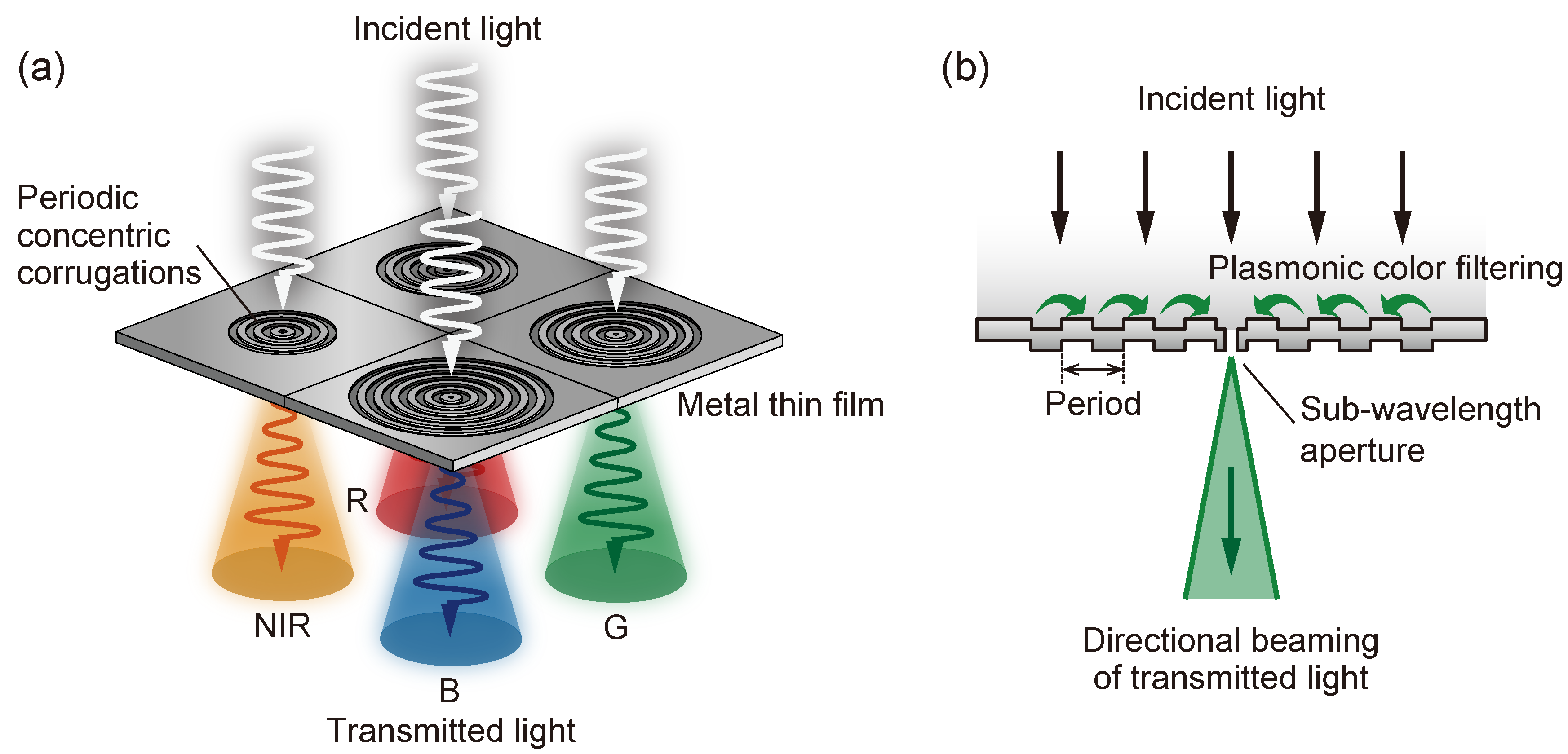Plasmonic Color Filter Array with High Color Purity for CMOS Image Sensors
Abstract
:1. Introduction
2. Proposed Multiband Plasmonic Color Filter
3. Numerical Simulation; AOI Dependence of Transmission Spectra
4. Fabrication Process
5. Results and Discussion
5.1. Transmission Color Purity of Plasmonic Color Filters with Periodic Concentric Corrugations
5.2. Dependence of Transmitted Light on Number of Grooves
5.3. Transmission Color Purity of Aperture-Array Filter with Square Configuration
6. Conclusions
Author Contributions
Funding
Acknowledgments
Conflicts of Interest
References
- Tominaga, S. Multichannel vision system for estimating surface and illumination functions. J. Opt. Soc. Am. A 1996, 13, 2163–2173. [Google Scholar] [CrossRef]
- Burns, P.D.; Berns, R.S. Analysis multispectral image capture. Available online: http://losburns.com/imaging/pbpubs/18cic1996burnsberns.pdf (accessed on 9 April 2019).
- Fukuda, H.; Uchiyama, T.; Haneishi, H.; Yamaguchi, M.; Ohyama, N. Development of a 16-band multispectral image archiving system. In Proceedings of the Electronic Imaging 2005, San Jose, CA, USA, 17–20 January 2005; Volume 5567, pp. 136–146. [Google Scholar]
- Gat, N. Imaging spectroscopy using tunable filters: A review. In Proceedings of the AeroSense 2000, Orlando, FL, USA, 5 April 2000; Volume 4056, pp. 50–65. [Google Scholar]
- Tominaga, S. Spectral imaging by a multichannel camera. J. Electr. Imaging 1999, 8, 332–342. [Google Scholar] [CrossRef]
- Brauers, J.; Aach, T. A color filter array based multispectral camera. In Proceedings of the 12th Workshop Farbbildverarbeitung, Koblenz, Germany, 5–6 October 2006. [Google Scholar]
- Li, Y.; Majumder, A.; Zhang, H.; Gopi, M. Optimized multi-spectral filter array based imaging of natural scenes. Sensors 2018, 18, 1172. [Google Scholar] [CrossRef]
- Yasuma, F.; Mitsunaga, T.; Iso, D.; Nayar, S.K. Generalized assorted pixel camera: Postcapture control of resolution, dynamic range, and spectrum. IEEE Trans. Image Process. 2010, 19, 2241–2253. [Google Scholar] [CrossRef] [PubMed]
- Bayer, B. Color Imaging Array. U.S. Patent 3,971,065, 20 July 1976. [Google Scholar]
- Degiron, A.; Ebbesen, T.W. The role of localized surface plasmon modes in the enhanced transmission of periodic subwavelength apertures. J. Opt. A Pure Appl. Opt. 2005, 7, S90–S96. [Google Scholar] [CrossRef]
- Laux, E.; Genet, C.; Skauli, T.; Ebbesen, T.W. Plasmonic photon sorters for spectral and polarimetric imaging. Nat. Photonics 2008, 2, 161–164. [Google Scholar] [CrossRef]
- Inoue, D.; Miura, A.; Nomura, T.; Fujikawa, H.; Sato, K.; Ikeda, N.; Tsuya, D.; Sugimoto, Y.; Koide, Y. Polarization independent visible color filter comprising an aluminum film with surface-plasmon enhanced transmission through a subwavelength array of holes. Appl. Phys. Lett. 2011, 98, 093113. [Google Scholar] [CrossRef]
- Chen, Q.; Das, D.; Chitnis, D.; Walls, K.; Drysdale, T.D.; Collins, S.; Cumming, D.R.S. A CMOS image sensor integrated with plasmonic colour filters. Plasmonics 2012, 7, 695–699. [Google Scholar] [CrossRef]
- Yokogawa, S.; Burgos, S.P.; Atwater, H.A. Plasmonic color filters for CMOS image sensor applications. Nano Lett. 2012, 12, 4349–4354. [Google Scholar] [CrossRef]
- Burgos, S.P.; Yokogawa, S.; Atwater, H.A. Color imaging via nearest neighbor hole coupling in plasmonic color filters integrated onto a complementary metal-oxide semiconductor image sensor. ACS Nano 2013, 7, 10038–10047. [Google Scholar] [CrossRef]
- Zeng, B.; Gao, Y.; Bartoli, F.J. Ultrathin nanostructured metals for highly transmissive plasmonic subtractive color filters. Sci. Rep. 2013, 3, 2840. [Google Scholar] [CrossRef] [PubMed]
- Fleischman, D.; Sweatlock, L.A.; Murakami, H.; Atwater, H. Hyper-selective plasmonic color filters. Opt. Express 2017, 25, 27386–27395. [Google Scholar] [CrossRef] [PubMed]
- Heydari, E.; Sperling, J.R.; Neale, S.L.; Clark, A.W. Plasmonic color filters as dual-state nanopixels for high-density microimage encoding. Adv. Funct. Mater. 2017, 27, 1701866. [Google Scholar] [CrossRef]
- Chen, Q.; Hu, X.; Wen, L.; Yu, Y.; Cumming, D.R. Nanophotonic image sensors. Small 2016, 12, 4922–4935. [Google Scholar] [CrossRef] [PubMed]
- Ebbesen, T.W.; Lezec, H.J.; Ghaemi, H.F.; Thio, T.; Wolff, P.A. Extraordinary optical transmission through sub-wavelength hole arrays. Nature 1998, 391, 667. [Google Scholar] [CrossRef]
- Miyamichi, A.; Ono, A.; Kamehama, H.; Kagawa, K.; Yasutomi, K.; Kawahito, S. Multi-band plasmonic color filters for visible-to-near-infrared image sensors. Opt. Express 2018, 26, 25178–25187. [Google Scholar] [CrossRef] [PubMed]
- Lezec, H.J.; Degiron, A.; Devaux, E.; Linke, R.A.; Martin-Moreno, L.; Garcia-Vidal, F.J.; Ebbesen, T.W. Beaming light from a subwavelength aperture. Science 2002, 297, 820–822. [Google Scholar] [CrossRef] [PubMed]
- Ishi, T.; Fujikata, J.; Makita, K.; Baba, T.; Ohashi, K. Si nano-photodiode with a surface plasmon antenna. Jpn. J. Appl. Phys. 2002, 297, 820–822. [Google Scholar] [CrossRef]
- Chen, Z.; Wang, X.; Liang, R. RGB-NIR multispectral camera. Opt. Express 2014, 22, 4985–4994. [Google Scholar] [CrossRef] [PubMed]
- Tang, H.; Zhang, X.; Zhuo, S.; Chen, F.; Kutulakos, K.N.; Shen, L. High resolution photography with an RGB-infrared camera. In Proceedings of the 2015 IEEE International Conference on Computational Photography (ICCP), Houston, TX, USA, 24–26 April 2015; pp. 1–10. [Google Scholar]
- Teranaka, H.; Monno, Y.; Tanaka, M.; Okutomi, M. Single-sensor RGB and NIR image acquisition: Toward optimal performance by taking account of CFA pattern, demosaicking, and color correction. In Proceedings of the IS&T Electronic Imaging 2016 (EI2016), San Francisco, CA, USA, 14–16 February 2016; pp. 1–6. [Google Scholar]







© 2019 by the authors. Licensee MDPI, Basel, Switzerland. This article is an open access article distributed under the terms and conditions of the Creative Commons Attribution (CC BY) license (http://creativecommons.org/licenses/by/4.0/).
Share and Cite
Miyamichi, A.; Ono, A.; Kagawa, K.; Yasutomi, K.; Kawahito, S. Plasmonic Color Filter Array with High Color Purity for CMOS Image Sensors. Sensors 2019, 19, 1750. https://doi.org/10.3390/s19081750
Miyamichi A, Ono A, Kagawa K, Yasutomi K, Kawahito S. Plasmonic Color Filter Array with High Color Purity for CMOS Image Sensors. Sensors. 2019; 19(8):1750. https://doi.org/10.3390/s19081750
Chicago/Turabian StyleMiyamichi, Atsutaka, Atsushi Ono, Keiichiro Kagawa, Keita Yasutomi, and Shoji Kawahito. 2019. "Plasmonic Color Filter Array with High Color Purity for CMOS Image Sensors" Sensors 19, no. 8: 1750. https://doi.org/10.3390/s19081750
APA StyleMiyamichi, A., Ono, A., Kagawa, K., Yasutomi, K., & Kawahito, S. (2019). Plasmonic Color Filter Array with High Color Purity for CMOS Image Sensors. Sensors, 19(8), 1750. https://doi.org/10.3390/s19081750



